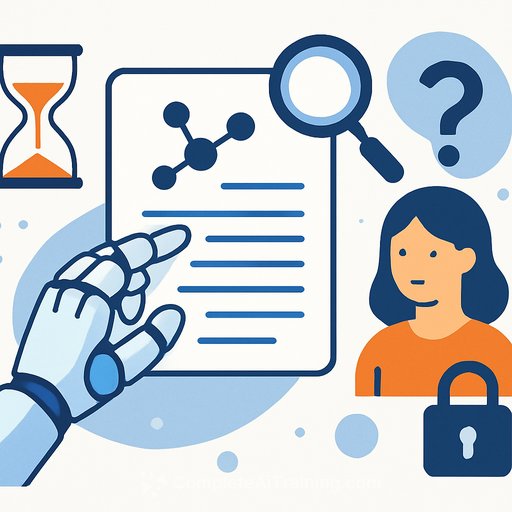National AI Ambitions Need a Data Governance Backbone. RDaF Can Provide It.
Compute is table stakes. The US is moving fast with initiatives like OMAI and the next phase of the NAIRR, but leadership in AI won't come from hardware alone. It will come from trust-earned through disciplined data governance across the full data lifecycle.
The shortest path to that trust is already available: NIST's Research Data Framework (RDaF). It is a practical, modular way for research teams, facilities, and agencies to govern data now-without waiting for new rules or building bespoke processes from scratch.
The missing layer: lifecycle data governance
Many AI implementation plans still treat data governance as an afterthought. That choice invites known problems at greater scale: opaque training pipelines, weak reproducibility, gaps in privacy and confidentiality, compliance uncertainty, and thin accountability for inputs, outputs, and downstream decisions.
This isn't just about LLMs. Embedded and autonomous systems trained on sensor data, simulations, and signals need provenance, metadata, versioning, and controlled access at least as much as text models do-especially in safety-critical contexts.
RDaF: the practical backbone
RDaF is a role-based, lifecycle framework that helps teams plan, generate, process, share, preserve, and retire data with consistent standards. It meets researchers where they are, integrates with existing practices, and focuses on outcomes: findable data, clear provenance, tiered access, and repeatable workflows.
It is non-regulatory, already familiar across federal science programs, and referenceable in guidance, funding conditions, and training-no new statute required.
What RDaF adds
- Security and accountability: Tiered access, provenance, and usage logs make it possible to trace model inputs and outputs, support export-control enforcement, and enable responsible sharing across open and secure environments.
- Interoperability and efficiency: Alignment with FAIR data principles, agency public access policies, the Evidence Act, and the Privacy Act reduces integration costs and supports cross-organization and cross-border collaboration.
- Adoptable today: Build on existing standards and infrastructure. Use it to close policy-to-practice gaps without slowing research velocity.
Why this matters now
Frontier models are shipping without transparent data governance. The result: lawsuits, safety incidents, and public skepticism. If the US wants trustworthy, efficient, and secure AI, data governance must be a first-order investment alongside compute.
As NAIRR and OMAI scale, RDaF gives operators, PIs, and sponsors a shared playbook for how data is collected, curated, described, accessed, reused, and audited. Where compute brings capability, data governance builds trust.
Quick-start playbook (first 90 days)
- Define roles and accountability: Assign data stewards, security leads, and model owners. Document who decides, who implements, and who audits.
- Stand up a data inventory: Catalog training, evaluation, and operational datasets with ownership, licensing, provenance, and sensitivity.
- Adopt metadata and IDs: Use standard schemas and persistent identifiers for datasets, versions, and model artifacts.
- Implement tiered access: Map datasets to access levels. Enforce least privilege with approval workflows and logging.
- Capture provenance: Record source, transformations, filters, and quality checks for every dataset and model release.
- Version everything: Data, labels, prompts, eval suites, and models. Enable rollback and reproducibility.
- Operationalize review: Add data governance checks to IRB, security, and model release gates. Audit quarterly.
- Train your team: Short sessions on privacy, licensing, access control, and documentation. Measure completion.
Policy-to-practice checkpoints
- For funders: Require a data governance plan aligned to RDaF for awards that include AI training or deployment. Tie milestones to inventories, metadata, and access control implementation.
- For facilities: Offer shared services for PIDs, metadata, lineage, and audit logging. Provide tiered environments for open and controlled data.
- For agencies: Reference RDaF in guidance and procurement. Use it to align with FAIR principles and existing mandates without adding red tape.
Risk signals to watch
- No authoritative data inventory or ownership records.
- Unclear licensing or consent for training data.
- Missing lineage for datasets, labels, and model versions.
- Shared accounts or ad hoc data access approvals.
- Model releases without documented dataset versions and evals.
The bottom line
Adopting RDaF won't end debates about AI, but it will scale the capacity to manage data with discipline. That's the foundation for trust-inside labs, across agencies, and with the public.
If national AI investments are to pay off, data governance can't trail compute by years. Put RDaF to work now, and make every dollar spent on GPUs count twice.
Resources
Skill up your team
Need structured upskilling for researchers and data stewards implementing governance and compliance workflows? Explore focused options by role here: Courses by Job.
Your membership also unlocks:






